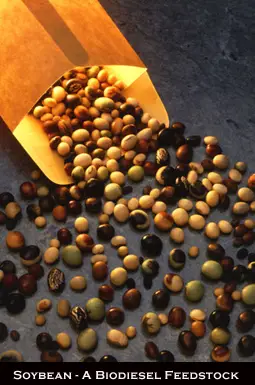Biofuel can be broadly defined as solid, liquid, or gas fuel consisting of, or derived from biomass. Use of fuels from biomass can reduce toxic air emissions, greenhouse gases, (depending on how much fossil fuel was used to produce the fuel in the first place) and dependence on diminishing oil reserves. Use of liquid fuels such as ethanol and biodiesel, derived primarily from agricultural crops, is increasing dramatically.
The energy balance is determined by the amount of energy put in to the manufacture of fuel compared to the amount of energy released when it is burned in a vehicle. Biofuels tend to require higher energy inputs per unit energy than fossil fuels: oil can be pumped out of the ground and processed more efficiently than bio-fuels can be grown and processed. However, this is not necessarily a reason to use fossil oil instead of organic fuels, but careful attention needs to be paid to the environmental benefits provided by any given product.

A further note of caution needs to be sounded, so we don’t divert too much food crop into biofuels production. With changing climatic conditions, our food supply is likely to be more erratic and we would not want demand for agricultural food going to fuel stocks and outstripping our capacity to supply food. The growing ethanol industry (that utilises grain) will also affect the supply of feed grain for livestock, particularly in drought years, and this will place upward pressure on the price of grain.
The unfortunate consequence will be an increase in food prices that might be so high people in poorer countries can’t afford to eat! Already and in early 2007 there were a number of reports about food riots in Mexico due to rising prices of corn for tortillas being used in bio-ethanol production.
In November 2007 one person was killed and several injured when food riots broke out in several provinces of Mauritania. Protesters were demonstrating over rising food prices, and an 18-year old was shot in Kansoaa by security forces after protesters attempted to invade the home of a local official. The rise of food transport costs, associated with the increase in oil prices, and biofuel production were blamed for the price hikes.
Australian Renewable Fuels Ltd, with three plants each producing over 40 million litres of biodiesel from tallow are likely to move to Mexico. Rising tallow feedstock prices are forcing closure of the plants, and whilst biodiesel from tallow does not compete with food, it does indicate how fickle this marketplace is.
Issues and Consequences of Production
To date, many countries have already established renewable energy mandates or targets. These targets include both production and use for biofuels. For instance, the United States set a target of producing 35 billion gallons of renewable fuel a year by 2017, an equivalent of almost five times the level currently mandated. Meanwhile, the EU directive calls for the substitution of 5.75% (energy equivalent) of overall fossil fuels demand by the year 2010, and proposes a 10% substitution by the year 2020.
With government mandates and subsidies such as these, production will continue to rise in the near future. However, a critical question emerges: at what cost will this unprecedented growth occur? Extensive biomass cultivation raises environmental and social concerns over competition for food, water shortages, deforestation and land degradation, among others.
Energy yields are highest from crops growing in the tropics; hence much of the global demand is being, and will continue to be, met from Asia, Latin America and Africa.
Already, biofuel production is leading to increased rates of deforestation forestland to make space for palm oil crops to cater for the increasing biodiesel demand. The impact is being felt in many rainforest nations, including Indonesia, Malaysia, Colombia, Brazil, Paraguay, Argentina and Cameroon. For example, Indonesia planned to expand palm oil production for biofuels 43-fold, a move that threatened most of that country’s remaining rain forests and peat lands. The environmental impact of other aspects of biofuel production, including the widespread cultivation of fast-growing jatropha (a plant that produces a toxic vegetable oil), are unknown.
It is fortunate that corn and other starches and sugar producing crops are only a small fraction of material that can be used to make ethanol. Other sources, such as agricultural and forestry residues, industrial waste, material in municipal landfills, trees, and grasses can be also be used. In many regions, rising demand threatens both the cost and availability of the crops to make this fuel. From 2003 to 2006, the percentage of the total US corn harvest used to produce biofuels rose to 16 percent, from 12 percent. But now that the US federal government has adopted a goal of 35 billion gallons of alternative fuels a year by 2017, the use of domestic corn-based bio ethanol to meet even half of this target would require 40 percent of that year’s expected harvest.
 It is not surprising that the cost of corn has already risen significantly. Average wholesale prices rose from $1.90 a bushel in 2005 to $2.41 in 2006, and corn has regularly surpassed $4 a bushel on the spot market since late 2006.
It is not surprising that the cost of corn has already risen significantly. Average wholesale prices rose from $1.90 a bushel in 2005 to $2.41 in 2006, and corn has regularly surpassed $4 a bushel on the spot market since late 2006.
o Food, livestock and fuel producers are competing for the same commodity crops in the international arena. About 61% of the world’s ethanol production comes from sugar crops. Corn-based ethanol production is growing by about 30% per year in the USA.
o Impacts include doubling of USA corn prices in 2006-7; rising prices of milk, eggs, chicken and tortillas in China, India, Mexico and the USA; in Europe rapeseed (canola) oil prices doubling over the last five years and the price of cereals, starches and glucose increased by about 20 % in the last year.
o Biofuel induced increases in global grain commodity prices are having an impact on Australian agricultural commodity prices, particularly in grain commodities. Non-grain agricultural commodity prices are also being buoyed by substitution of global planting area with biofuel crops.
o Currently ethanol from waste starch and C-molasses, and biodiesel from waste oil can be produced at a cost less than 45c/L (roughly competing with oil at US$40/barrel). Ethanol from sugar, and biodiesel from tallow and canola can be produced for less than 80c/L (roughly competing with oil at US$80/barrel). High variability in cost of production is largely due to variations in the cost of feedstock.
o There will be increasing competition with grains for food, and with feedgrain for the livestock industry if the ethanol industry significantly expands production capacity and beyond. Likewise, expansion of the biodiesel industry will increase competition with soap and detergent manufacturers for feedstock.
o There will be a whole new set of markets for second generation (lignocellulosic) feedstocks, which have not been fully developed or explored. Although some existing biomass sources do not have existing markets, they may have existing uses (eg retaining carbon in ecosystems, providing habitat).
o In the case of a large scale bio-fuel industry, there are likely to be competing markets not just for the feedstocks, but also the factors of production including land, water and labour which would then impact on many other industry sectors.
If you are interested in the ethics of alternative fuel, there is a informative paper called, Initial Ethical Evaluations of Alternative Energy Strategies: the Example of Biofuels by Erich W. Schienke.
If you want to save money on your gas, go “green” and find out how to make your own biodiesel at home….
Supplies of oil are going down all the time and this means that prices will continue to rise. At the time of writing this sentence oil prices are soaring and fluctuating wildly (current price below).
|
||||||||||
|
||||||||||
REPORTS
The reports are all pdf files. Simply right click and save as.
1. A Look Back at the U.S. Department of Energy’s Aquatic Species Program: Biodiesel from Algae- Close out report.
2. Fuels of the Future for Cars and Trucks
3. Life Cycle Inventory of Biodiesel and Petroleum Diesel for Use in an Urban Bus
4. NREL – Biodiesel Production Technology
5. Using Unmodified Vegetable Oils as a Diesel Fuel Extender
|
Biomass Technologies
Landfill Gas What is Biofuel? Palm Oil Biodiesel Biodiesel from Algae Make Algae Biodiesel at Home Ethanol Biofuel Biofuel Ethics Wood Gas Generator
|





